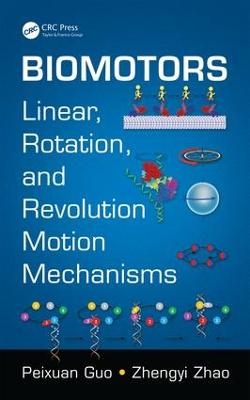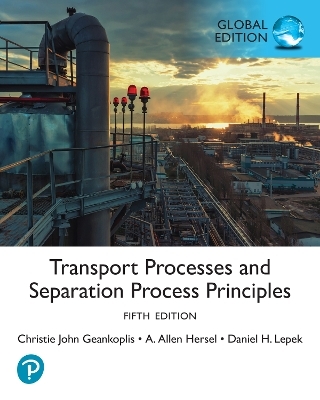
Biomotors
Crc Press Inc (Verlag)
978-1-4987-0986-6 (ISBN)
Peixuan Guo is currently the Sylvan G. Frank Endowed Chair in Pharmaceutics and Drug Delivery at The Ohio State University College of Pharmacy, and director of the Center for RNA Nanobiotechnology & Nanomedicine at OSU. After 17 years serving as a professor and center director at Purdue University, he became endowed chair of biomedical engineering at the University of Cincinnati, then a endowed chair of Cancer Nanotechnology and director of the Nanobiotechnology Center at the University of Kentucky before moing to the Ohio State. He is the founding president of the International Society of RNA Nanotechnology and Nanomedicine and founder He received his Ph.D. in microbiology from the University of Minnesota in 1987 and was an NIH postdoctoral fellow in 1990, assistant professor at Purdue in 1990, tenured in 1993, full professor in 1997, and honored as Purdue Faculty Scholar in 1998. He was also director of the NIH Nanomedicine Development Center from 2006 to 2011. His recognitions include the Pfizer Distinguished Faculty Award in 1995, Lions Club Cancer Research Award in 2006, distinguished alumnus of the University of Minnesota in 2009, and Distinguished Chinese Alumnus of the 100 Years of the University of Minnesota in 2014. He is the editorial board member of five nanotech journals, has reported hundreds of times on television (such as ABC, NBC, and BBC), and has been frequently featured on the websites of the NIH, NSF, MSNBC, and NCI. He is a member of two prominent national nanotech initiatives sponsored by NIST/NIH/NSF and the National Science and Technology Council. He has been a member of the Foreign Examination Panel of the Chinese Academy of Sciences since 2014. He is a cofounder of P&Z Biological Technology, a consultant of Oxford Nanopore Technologies and Nanobio Delivery Pharmaceutical Company. Peixuan is the world-recognized founder and pioneer of the RNA Nanotechnology field. He constructed the first viral DNA packaging motor in vitro (PNAS, 1986), discovered the phi29 motor pRNA (Science, 1987), assembled infectious dsDNA viruses (J Virology, 1995), discovered the pRNA hexamer (Mol Cell, 1998, featured in Cell), and pioneered RNA nanotechnology (Mol Cell, 1998, JNN, 2003; Nano Letter., 2004, 2005; Nature Nanotechnology 2010, 2011). His lab built a dual imaging system to detect single-fluorophores (EMBO J, 2007; RNA, 2007) and incorporated the phi29 motor channel into a lipid membrane (Nature Nanotechnology, 2009) for single molecule sensing with potential for high throughout dsDNA sequencing. Recently, his lab discovered a third class of biomotor using revolution mechanism without rotation. Zhengyi Zhao received her Ph.D. degree from the University Of Kentucky College Of Pharmacy in 2016 under the guidance of Professor Peixuan Guo, one of the world's top scientists in the field of RNA nanotechnology. She obtained her bachelor’s degree at Shenyang Pharmaceutical University in 2011. She has broad training in molecular biology, nanobiotechnology, biophysics, and pharmaceutics. Her research focuses on the study of the function, mechanism, and application of the bacteriophage phi29 dsDNA packaging nanomotors, and her research work has been reported by many media sources. Ian Grainge, Ph.D., is currently a Lecturer at the University of Newcastle, Australia and Australian Research Council Future Fellow. After receiving his B.A. (1994) and M.A. (1995) from the University of Cambridge, UK, he received his Ph.D. at the University of Oxford, UK in 1997. Later, he did postdoctoral research at the University of Texas, Austin; Cancer Research UK, Clare Hall Laboratories; and The University of Oxford. His research focus is on genomic stability, with an interest in the many mechanisms that organisms employ to keep their genomes intact and pass on that information to subsequent generations. This includes DNA replication, recombination, DNA repair and chromosome partitioning and segregation. The goal is to understand these processes at the molecular level, and there is a particular fascination with molecular machines, such as helicases and DNA translocases, that underlie many of the vital processes in the cell. Ian has 20 years of experience in the area of recombination and 15 years of work on molecular motor proteins. Professor Hiroyuki Noji, Ph.D., a Professor at the Department of Applied Chemistry, The University of Tokyo, and is a Single-Molecule Biophysicist. He has been studying the chemomechanical coupling mechanism of FoF1 ATP synthase by the use of single-molecule techniques. He is also known as an inventor of the femtoliter chamber array system for Single-Molecule Enzymatic assays that is currently applied in single-molecule digital ELISA. Professor Noji was trained under the supervision of Prof. Masasuke Yoshida and received his Ph.D. from Tokyo Institute of Technology in 1997. After a postdoctoral fellowship in the laboratory of Prof. Kazuhiko Kinosita, Jr., he was appointed an Associate Professor at the Institute of Industrial Science, The University of Tokyo in 2001. In 2005, he moved to the Institute of Scientific and Industrial Research, Osaka University as a full professor. Since 2010, he has been a Professor at the Department of Applied Chemistry, The University of Tokyo. Christopher M. Yengo, Ph.D. received his doctoral degree in molecular physiology and biophysics from The University of Vermont and did his postdoctoral work at The University of Pennsylvania. He was an Assistant Professor in the Biology Department at The University of North Carolina at Charlotte and is currently an Associate Professor in The Department of Cellular and Molecular Physiology in The College of Medicine at Pennsylvania State University. He is interested in the fundamental mechanism of myosin-based force generation, the function of non-muscle myosins, regulation of the actin cytoskeleton, and the role of myosin mutations in heart disease and deafness. Fnemgi Pi received her Ph. D. degree from the University of Kentucky, College of Pharmacy in 2016 under the guidance of Professor Peixuan Guo. She obtained her B.S. and M.S. from China Pharmaceutical University in 2007. She worked as a research scientist at Deawoong Pharmaceuticals Co. Korea; and senior formulation scientist in China GSK Consumer Healthcare before joining the University of Kentucky in 2012. She has broad training and working experience in pharmaceutical science. Her research focuses on RNA nanotechnology for targeted drug delivery and cancer therapy, and her search work has been reported by media sources.
Classifications and typical examples of biomotors, Structure of revolving biomotors, Structure of rotation motors, Structure of linear motors, Distinguishing revolving motors from rotation motors, General Mechanism of biomotors, Mechanism of revolving motors, Mechanism of rotation motion, Mechanism of linear motion, and Applications of the revolving motor.
| Erscheinungsdatum | 23.11.2017 |
|---|---|
| Zusatzinfo | 25 Illustrations, color; 15 Illustrations, black and white |
| Verlagsort | Bosa Roca |
| Sprache | englisch |
| Maße | 156 x 234 mm |
| Gewicht | 362 g |
| Themenwelt | Technik ► Umwelttechnik / Biotechnologie |
| ISBN-10 | 1-4987-0986-9 / 1498709869 |
| ISBN-13 | 978-1-4987-0986-6 / 9781498709866 |
| Zustand | Neuware |
| Haben Sie eine Frage zum Produkt? |
aus dem Bereich


